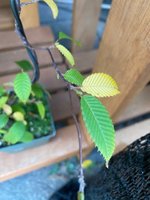takira
Yamadori
Apologies if this is an utterly daft question - new to the hobby and desperate not to screw up the basics.
I have a Japanese Hornbeam seedling that was acquired in mid-July and has been thriving since, but in the past few weeks has been having seemingly random yellowing and dropping of leaves. I get that it's deciduous, but it also seems to be pushing buds at the same time. Is this just setting buds for the spring? I haven't seen any obvious external parasites, the leaves that are remaining green seem healthy, and I suspect that I'm just being an idiot about a natural process, but wanted to be sure that I'm not missing something important before it goes dormant for the fall. For reference, I'm in southeast Michigan and the weather here has been exceedingly variable of late - highs were in the low eighties day before yesterday and are projected to be in the mid-fifties for most of next week.
Thanks for any help!
I have a Japanese Hornbeam seedling that was acquired in mid-July and has been thriving since, but in the past few weeks has been having seemingly random yellowing and dropping of leaves. I get that it's deciduous, but it also seems to be pushing buds at the same time. Is this just setting buds for the spring? I haven't seen any obvious external parasites, the leaves that are remaining green seem healthy, and I suspect that I'm just being an idiot about a natural process, but wanted to be sure that I'm not missing something important before it goes dormant for the fall. For reference, I'm in southeast Michigan and the weather here has been exceedingly variable of late - highs were in the low eighties day before yesterday and are projected to be in the mid-fifties for most of next week.
Thanks for any help!

